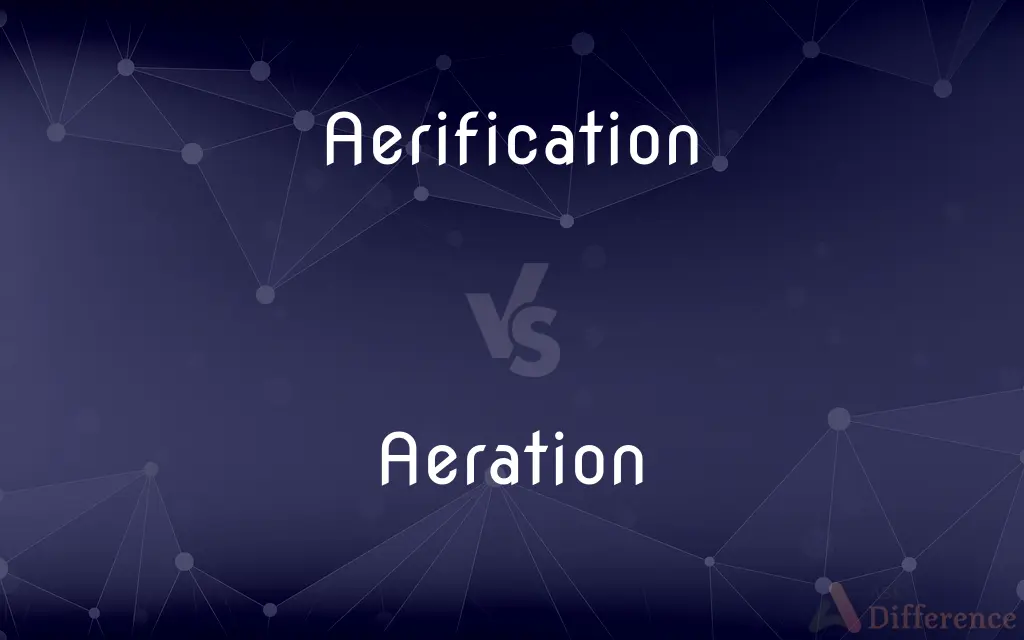Aerification vs. Aeration — What's the Difference?
By Tayyaba Rehman & Fiza Rafique — Updated on April 19, 2024
Aerification is a specific soil process using mechanical means to create holes, enhancing root growth and drainage; aeration generally refers to increasing air circulation in any medium or environment.

Difference Between Aerification and Aeration
Table of Contents
ADVERTISEMENT
Key Differences
Aerification often involves mechanically puncturing the soil with spikes or coring devices to create air gaps and reduce soil compaction. This specific method benefits soil by allowing air, water, and nutrients to penetrate deeper into the root zones of plants. Whereas, aeration broadly describes the process of introducing air into a medium, which can apply to soil, water, or any other substance that benefits from increased oxygen exposure.
In lawn care, aerification is a targeted intervention meant to alleviate problems like heavy thatch build-up and soil compaction that can impede lawn health and growth. On the other hand, aeration could simply involve raking or turning over the soil, or it could refer to aerating water in a pond or aquarium to ensure adequate oxygen levels for aquatic life.
Aerification tools include spike aerators, which push solid tines into the soil, and core aerators, which remove plugs of soil to improve structure and drainage. Conversely, aeration techniques can vary widely depending on the context, from using an aerator on a pond to employing a fan in a room to improve air circulation.
The goal of aerification in gardening and agriculture is to create a healthier environment for roots by mechanically modifying the soil structure. In contrast, aeration might not always involve physical modifications; it could be as simple as stirring a liquid to expose it to more air.
Aerification is typically more labor-intensive and requires specialized equipment, making it less frequently performed but highly beneficial for compacted soils. Aeration, being a broader term, can be part of regular maintenance routines, like aerating a lawn with a simple garden fork or using an air pump in an aquarium.
ADVERTISEMENT
Comparison Chart
Definition
Mechanical process creating air gaps in soil
Increasing air circulation broadly in any medium
Primary Use
Improve soil structure for root growth
Enhance oxygen content and circulation
Tools/Equipment
Spike and core aerators
Aerators, fans, rakes
Frequency of Use
Periodically in intense maintenance
As needed, depending on context
Typical Application
Lawns, golf courses, athletic fields
Gardens, ponds, rooms
Compare with Definitions
Aerification
Involves removing soil cores to promote root growth.
Regular aerification prevents soil from becoming unyieldable.
Aeration
The process of increasing air contact with a liquid or substance.
Aeration of the pond water helped improve fish health.
Aerification
The process of creating air gaps in soil using mechanical means.
They scheduled aerification for the golf course to improve turf health.
Aeration
Used broadly from gardening to environmental management.
They aerated the compost to speed up decomposition.
Aerification
A soil maintenance technique to reduce compaction.
Aerification helped restore the dense, trampled lawn.
Aeration
Can be achieved using various tools or natural processes.
The breeze aided in the aeration of the greenhouse.
Aerification
Enhances water and nutrient absorption by soil.
Post-aerification, the field absorbed the rain much better.
Aeration
Simple methods like stirring or exposing to air.
Aeration of the wine brought out its richer flavors.
Aerification
Necessary for sports fields to maintain playing surface integrity.
The football field undergoes aerification twice a year.
Aeration
Improves environments by adding oxygen.
Aquarium aeration is essential for sustaining aquatic life.
Aerification
Aeration, especially of the soil.
Aeration
Aeration (also called aerification or aeriation) is the process by which air is circulated through, mixed with or dissolved in a liquid.
Aerification
Transformation into air or gas.
Aeration
To supply with air or expose to the circulation of air
Aerate soil.
Aerification
The act of combining air with another substance, or the state of being filled with air.
Aeration
To expose to oxygen, as in the oxygenation of the blood by respiration.
Aerification
The act of becoming aërified, or of changing from a solid or liquid form into an aëriform state; the state of being aëriform.
Aeration
To supply or charge (liquid) with a gas, especially to charge with carbon dioxide.
Aeration
The process by which air is circulated through or mixed with a substance such as soil or a liquid.
Aeration
By extension, a process in which other gases (such as carbon dioxide or nitrogen or argon) are circulated through or mixed with a substance (usually liquid), sometimes with the consequence of increasing the transfer of air into the same liquid at the surface due to the induced circulation.
Aeration
Exposure to the free action of the air; airing; as, aëration of soil, of spawn, etc.
Aeration
A change produced in the blood by exposure to the air in respiration; oxygenation of the blood in respiration; arterialization.
Aeration
The act or preparation of charging a liquid with carbon dioxide gas to make it effervescent.
Aeration
The act of charging a liquid with air or oxygen for the purpose of purification.
Aeration
The process of exposing to air (so as to purify)
Aeration
The act of charging a liquid with a gas making it effervescent
Common Curiosities
What are the benefits of aeration in an aquarium?
Aeration in an aquarium increases oxygen levels, essential for fish and plant health.
What is the main purpose of aerification?
Aerification primarily aims to alleviate soil compaction, enhancing root growth and nutrient uptake.
How does aerification affect soil health?
Aerification improves soil health by breaking up compacted layers, allowing roots to expand and access more nutrients.
Can aeration help with water drainage?
Yes, aeration can improve water drainage by preventing soil surfaces from becoming impermeable.
What tools are used for simple soil aeration?
Tools like garden forks and manual aerators can be used for basic soil aeration tasks.
Does aeration have a role in environmental management?
Yes, aeration is crucial in environmental management, such as in wastewater treatment to reduce pollutants.
What is spike aerification?
Spike aerification involves pushing spikes into the soil to create air channels without removing soil cores.
How often should aerification be performed on a lawn?
Typically, aerification should be done annually or biannually, depending on the soil compaction and lawn health.
What's the difference between manual and mechanical aerification?
Manual aerification uses simple tools and is labor-intensive, while mechanical aerification uses powered equipment for efficiency.
What is core aerification?
Core aerification involves removing plugs of earth to relieve compaction and promote air, water, and nutrient movement through the soil.
How does aerification benefit athletic fields?
It prevents compaction from heavy use, maintaining a safer and more playable surface.
Is aeration necessary for all types of gardens?
While not always necessary, aeration can benefit gardens with dense soil or poor drainage.
Can aeration improve the taste of beverages?
Aeration, like decanting wine, can enhance flavor by allowing the beverage to breathe.
How does aerification help in water conservation?
By improving soil structure and drainage, aerification helps soil retain water more effectively, reducing the need for frequent watering.
Why is aeration important in composting?
Aeration speeds up the composting process by increasing microbial activity that breaks down organic matter.
Share Your Discovery

Previous Comparison
Saga vs. Legend
Next Comparison
Romance vs. SeductionAuthor Spotlight
Written by
Tayyaba RehmanTayyaba Rehman is a distinguished writer, currently serving as a primary contributor to askdifference.com. As a researcher in semantics and etymology, Tayyaba's passion for the complexity of languages and their distinctions has found a perfect home on the platform. Tayyaba delves into the intricacies of language, distinguishing between commonly confused words and phrases, thereby providing clarity for readers worldwide.
Co-written by
Fiza RafiqueFiza Rafique is a skilled content writer at AskDifference.com, where she meticulously refines and enhances written pieces. Drawing from her vast editorial expertise, Fiza ensures clarity, accuracy, and precision in every article. Passionate about language, she continually seeks to elevate the quality of content for readers worldwide.














































